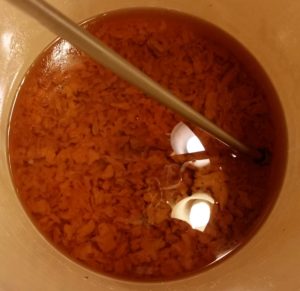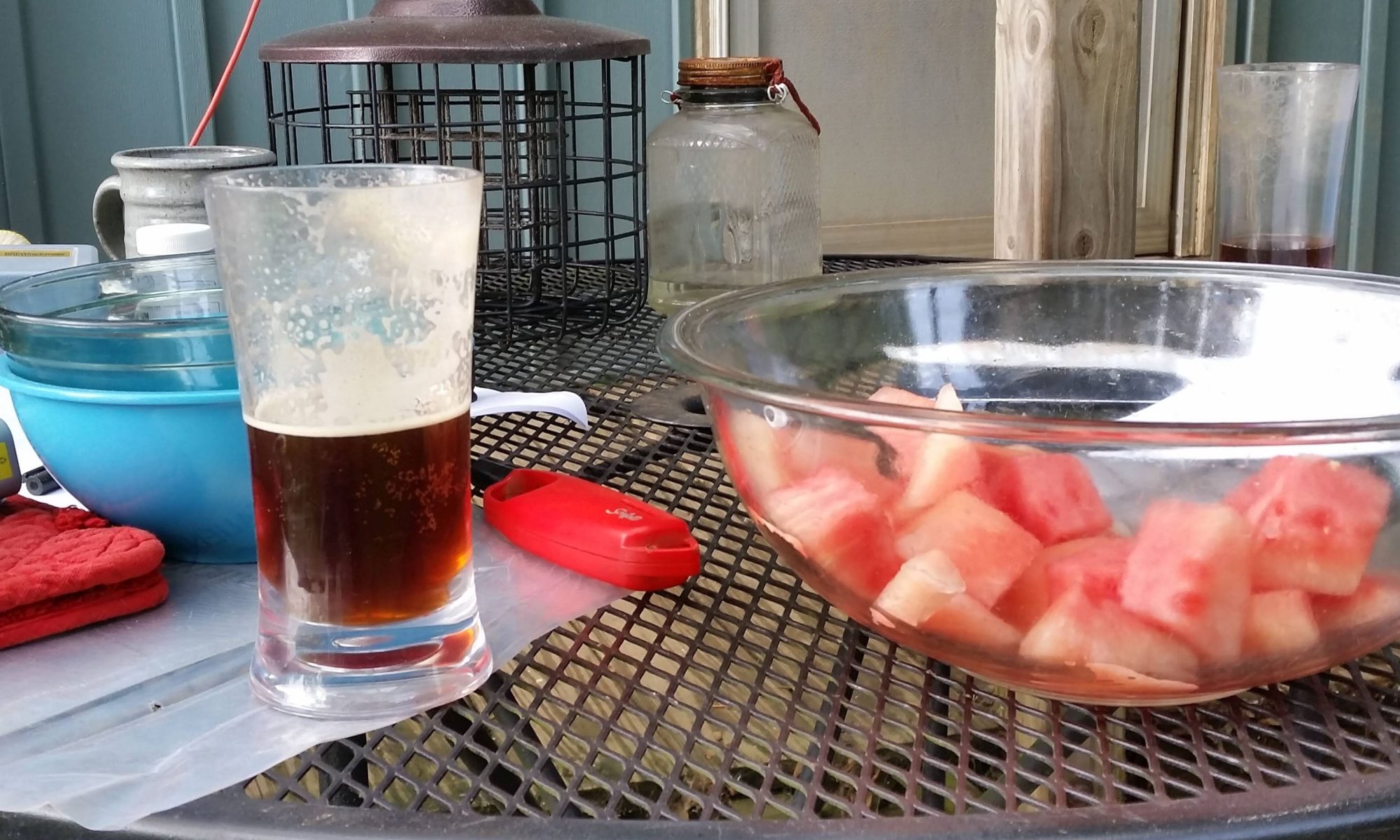The brewday for this month went of well, with the weather finally deciding to cooperate after a solid week of rain. Downtown flooded, but as we’re on a hill, with a slope away from the house in all directions, we didn’t get any of that. There was a little water seepage in the cellar, but the full extent was a little bit of mud.
Two batches were brewed: a Pils for my friend Dominick, based on a Stella Artois clone, and an experiment for myself, which I’ll get to in a moment. The pils I believe is going to be nice, if not exactly “to style.” I don’t have a setup right now to truly lager, but I can ferment fairly cool in the cellar. It was a simple grain bill, with 9.5 pounds of Pilsner malt. The hops were Saaz, added at the beginning, and with 5 minutes to go in the boil (1.5 ounces and .5 ounces, respectively). Dominick picked out WLP830, German Lager yeast. Volumes came out decently, and the gravity ended at about 1.046; I think it’ll be about 4.5% ABV, and the color should be straw gold. The hope is to have it ready for Pennsic.
The other batch was, as I mentioned, a bit of an experiment. The recipe was a riff off of my “scaled” Braunschweig Stadtmumme recipe: Munich and Vienna malts, with a healthy dose of German hops. I went for the higher-Alpha Herkules, rather than Tettnang, partly because I wanted something with some bittering to balance the Munich, and partly because I wanted to try them out. Nottingham yeast, to keep things simple. (The full recipe will be below.)
The crux of the “experiment” part, though, was the mash. Rather than my typical infusion/batch-sparge style, I went with a direct-fired mash, starting everything (grains and water together) at room temperature. This, again, is based on my reading of the Mumme recipes. They didn’t infuse, nor did they decoct; rather, they heated the mash for an hour and a quarter. That timeframe confused me at first, because it almost sounded like they were “simply” mashing for 75 minutes. But the more I thought about it, the more I figured that a properly-shaped vessel, with a strong enough fire under it, would probably get the volumes given in the original recipe (2172 pounds of grain, with “enough” water) up to the right temperatures in about that amount of time.
I went with 16 pounds of grain overall, and water to bring the overall volume up to about 9.75 gallons (about 34 quarts, give or take). With a pretty low flame on my propane burner, it took me about an hour–near enough to the original time–to get to my target mash temperature of 152 degrees F. I stirred constantly, to try to prevent any scorching, but still got a small amount (maybe 4 square inches of “scorch”).
My reasoning for starting from room temperature is that they didn’t specify any mash steps, and didn’t indicate adding the malt to hot water. The ramp up from ~70 degrees F progressively all the way to ~152 F took the mash through all of the intermediate steps–liquefaction, acid rest, protein rest, glucan, then saccharification. Rather than discrete steps, they “slid” up through the entire scale.
Once I had the mash at temp, I turned off the burner, and a friend and I transferred the mash to my “normal” mash tun (an Igloo cooler, with a false bottom). I let it sit another 20 minutes, partly to complete whatever conversion it was going to do, and partly to let the grain bed settle somewhat. Then I ran off the wort, using a large bowl to recirculate the first gallon or so.
My yield pre-boil was a little lower than I might have liked, netting about 6.5 gallons; while the kettle I fired the mash in could have held more, the cooler was about at its limit. (I either need to make the beer “smaller,” with less grain, or find a bigger mash tun.) Otherwise, everything went off without a hitch. The batch is currently happily fermenting in my cellar, and I’ll have to wait until next month to see how things have gone.
 One other “achievement” for today was kegging last month’s batch. It turned out quite nicely, as a sort of “lawn-mower beer.” Pale golden, light in body, and astoundingly clear. In fact, here’s a picture of the last few inches of beer in the fermenter, with the sediment clearly visible through it. I think this will be a lovely Pennsic beer, nice and crisp and thirst-quenching.
One other “achievement” for today was kegging last month’s batch. It turned out quite nicely, as a sort of “lawn-mower beer.” Pale golden, light in body, and astoundingly clear. In fact, here’s a picture of the last few inches of beer in the fermenter, with the sediment clearly visible through it. I think this will be a lovely Pennsic beer, nice and crisp and thirst-quenching.
This month’s recipe, with ingredient links to MoreBeer:
Closer to Stadtmumme
11 pounds of Munich Malt
5 pounds of Goldpils Vienna Malt
1.5 ounces of Herkules leaf hops (11.3% Alpha, first wort hops)
1 Whirlfloc tablet (15 minutes in the boil)
1.5 ounces of Herkules leaf hops (11.3% Alpha, 10 minutes in the boil)
1 packet Nottingham dry yeast
Direct-fire the mash from room temp up to ~152 degrees, over the course of an hour. Initial boil volume ~6.5 gallons. Boil 1 hour. Final volume, 5 gallons. Initial Gravity: 1.073.

